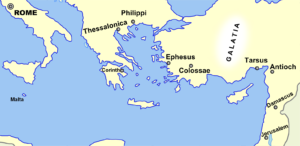
The ancient city of Colossae was located in a geographic area associated with the modern-day nation of Turkey. Colossae was situated in the southern portion of a valley that also included the Biblical cities of Ephesus, Laodicea, and Heirapolis. Earlier in its history, the city of Colossae held a prominent position as a commercial center that specialized in the production of dyed wool products. However, things had changed considerably by the time the Biblical letter to the Colossians was written.
Much like a modern-day town that begins to decline after it has been bypassed by a new railroad or highway, the city of Colossae suffered much the same fate. When the Roman Empire circumvented Colossae with a new east-west thoroughfare, the city’s geographic importance began to diminish. Colossae’s economy started to contract and by the middle of the first century, it had become little more than a small Mediterranean village. In the words of one scholar, “Colossae was a fairly unimportant market town, easily the least significant city to which any of Paul’s surviving letters were addressed.” (1)
If that wasn’t enough, Colossae (along with some of its neighboring cities) was damaged by an earthquake that took place in AD 60 or 64. Today, there is little evidence that the ancient city of Colossae ever existed. One source describes the 21st century condition of what remains of Colossae…
“Today the site of Colosse lies deserted, as does the neighboring site (about eight miles east) of Laodicea. Across the river valley twelve miles to the north, Hierapolis, with its famous mineral pools and springs, is the scene of a small resort; its ruins are impressive.
Colosse is the most isolated and unimpressive of the three ancient sites. It can be reached only by a dirt road, at the end of which lies a small Turkish village called Honaz. A couple of miles distant, in farming fields accessible only on foot or by tractor, lie the remains of ancient Colosse. While plowing their fields, local farmers have turned up some ruins of the Roman era. The site has never been systematically excavated.” (2)
As another commentator observes, “It is doubtful that we would ever have heard of this town had it not been that the gospel was preached there and souls were saved.” (3)
This is the backdrop from which the New Testament epistle to the Colossians begins to emerge. We’ll take a closer look at the authorship and context of this letter next.
Image credit: User:Alecmconroy [CC BY-SA 3.0 (https://creativecommons.org/licenses/by-sa/3.0)] https://commons.wikimedia.org/wiki/File:Broad_overview_of_geography_relevant_to_paul_of_tarsus.png
(1) Sproul, R. C. (Ed.). (2015). The Reformation Study Bible: English Standard Version (2015 Edition) (p. 2117). Orlando, FL: Reformation Trust.
(2) McCown, Wayne. “II. The City of Colosse” In Asbury Bible Commentary. 1078. Grand Rapids: Zondervan, © 1992.
(3) William Macdonald, Believer’s Bible Commentary Edited by Arthur Farstad Thomas Nelson Publishers p.2033

